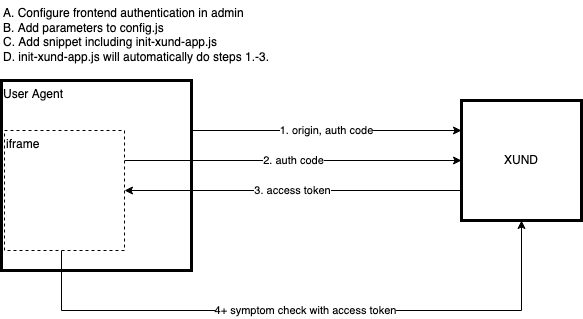Authentication Guide
The frontend authentication flow of the Web App works based on an auth code, generated by the frontend, which is then used to request an access token to be included in the headers of each request.
Frontend authentication flow
See the following step-by-step guide for embedding the XUND Web App and initializing authentication.
Referenced variables
The following variables are referenced in the examples. By replacing them with the proper values the example codes do the authentication.
Variable name | Environment | Value |
|---|---|---|
| BETA |
|
CLASS2 |
| |
| BETA |
If you work with a branded Web App, the Web App config’s code must be part of the base URL For example: |
CLASS2 |
If you work with a branded Web App, the Web App config’s code must be part of the base URL For example: | |
| Unique Client ID generated for your API key in the Client Hub | |
Implementation steps
Create a .js file with the following content and host it near the page where you want to do the integration. In this example, we will name it as frontend-auth.js:
import { CLIENT_ID, CH_ID_API_BASE_URL, WEBAPP_BASE_URL } from './config.js'
const initAuth = async () => {
const appendSearchParamsIfSet = (url, searchParams) => {
for (const [name, value] of Object.entries(searchParams)) {
if (value) {
url.searchParams.append(name, value)
}
}
}
const wrapperSearchParams = new URLSearchParams(window.location.search)
const clientId = wrapperSearchParams.get('clientId') || CLIENT_ID
const code = wrapperSearchParams.get('code') ?? ''
const birth = wrapperSearchParams.get('birth')
const gender = wrapperSearchParams.get('gender')
const checkId = wrapperSearchParams.get('checkId')
const state = wrapperSearchParams.get('state')
const directCheck = wrapperSearchParams.get('directCheck')
const authCode = crypto.randomUUID?.() ?? crypto.getRandomValues(new Uint32Array(40)).join('')
const authorizeRequestUrl = new URL(`${CH_ID_API_BASE_URL}/authorize`)
appendSearchParamsIfSet(authorizeRequestUrl, { clientId, authCode, state })
await fetch(authorizeRequestUrl)
const webappUrl = new URL(`${WEBAPP_BASE_URL}/${code}`)
appendSearchParamsIfSet(webappUrl, { birth, gender, checkId, state, directCheck })
const tokenRequestUrl = new URL(`${CH_ID_API_BASE_URL}/token`)
appendSearchParamsIfSet(tokenRequestUrl, { clientId, authCode, redirectUri: webappUrl })
document.getElementById('xund-iframe').src = tokenRequestUrl
}
initAuth()
window.addEventListener('message', async (e) => {
if (e.origin !== WEBAPP_BASE_URL) {
return
}
if (e.data.type === 'refresh') {
initAuth()
}
})Create a config.js file to export the custom variables needed for the integration in the same directory with frontend-auth.js. Don’t forget to change the values of the variables (
CLIENT_ID, CH_ID_API_BASE_URL, WEBAPP_BASE_URL):
export const CLIENT_ID = YOUR_CLIENT_ID
export const CH_ID_API_BASE_URL = XUND_AUTH_BASE_URL
export const WEBAPP_BASE_URL = XUND_APP_BASE_URLLoad frontend-auth.js and create a container iframe too on the page where you want to do the integration (example):
<!DOCTYPE html>
<html lang="en" style="height: 100%">
<head>
<title>XUND Web App</title>
<script src="frontend-auth.js" type="module"></script>
<meta name="viewport" content="width=device-width, initial-scale=1" />
</head>
<body style="height: calc(100% + 6px); margin: 0; overflow: hidden">
<iframe
allow="geolocation"
id="xund-iframe"
style="width: 100vw; height: 100vh; border: none"
title="Web App Frame"
/>
</body>
</html>Definitions
frontend | A user-facing application embedding a XUND web app, where it’s a requirement to avoid storing a permanent |
|---|---|
backend | An application inaccessible to end-users, viable for storing secrets. For setting up a backend-based authentication see Setting up a backend for secure authentication |
auth code | A short-lived expiring token used for requesting an |
access token | The XUND auth module sends this expiring token in the header of each request. When an |
API key | A pre-registered secret used for identifying a client |
origin | A pre-registered hostname pointing to the |
